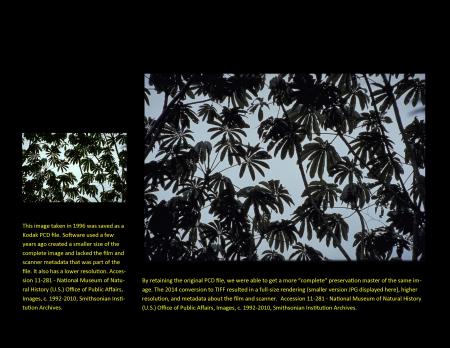When it comes to digital preservation the work is never truly finished. As we have written before, our best practices with digital curation and preservation involve keeping the original file in its original format as well as creating a file in a preservation format when possible.
For instance if we have an older Microsoft Word document, we will keep it and also create a PDF version of that file as its preservation master. If a researcher is interested in the file, they will get a PDF copy since it is a standard format and easy to access.
Benefits of retaining the original version:
- It is good to have it in case the preserved copy becomes corrupted.
- If the file cannot be accessed now, software and/or emulators may be developed eventually that can read it. Emulators are used quite often with old video games.
- Better software can be developed that can render a “better” file that is more complete, such as displaying metadata or displaying at original size.

Kodak Photo CD (PCD) files are one such example of original files that have benefitted from being revisited. Developed film was scanned onto CDs that contained up to 100 images and saved as the proprietary PCD format rather than the more familiar JPEG or TIFF. Kodak no longer supports the product.
Offices across the Smithsonian have these CDs and the Archives is no exception. We have a manageable number from our collections that total approximately 1,000. Some of them were converted previously into TIFF preservation files, but we were not capturing the “entire” file with the software we were using. The file size was set to a smaller one during conversion to a TIFF from its original size on the CD. Meanwhile, other software that could convert the PCD files discontinued the plug-in that was needed in software upgrades.
A few years later there are now more software conversion options available to handle these obsolete files. You can find some by searching “PCD conversion” online. Our latest conversion to TIFF files has resulted in full-size files with higher resolution and metadata about the film and scanner that was not present with the other software. All our collections with PCD files have been converted to these “better” versions.
If you have older files that are in obsolete formats, here are some things to consider:
- Convert a copy of the file to a more sustainable format. Example: old word-processing file to a PDF.
- View the original (if you can) to compare the migrated file to it. Does the look and feel match? Is that important for the document to you? Is metadata present?
- Consider retaining the original file in case you can get a “better” version of it later.
- Don’t forget to monitor the preserved/converted file itself for obsolescence.
Related Resources
- History of Kodak, 1990-1999, Kodak
- Whatever Happened to Photo CD?, by Brian P. Lawler, Creative Pro
- Recuperating Zip files . . . Image Media Workflow, by Kelley Shanahan, CoDA blog, Center for Digital Archaeology
Produced by the Smithsonian Institution Archives. For copyright questions, please see the Terms of Use.

Leave a Comment